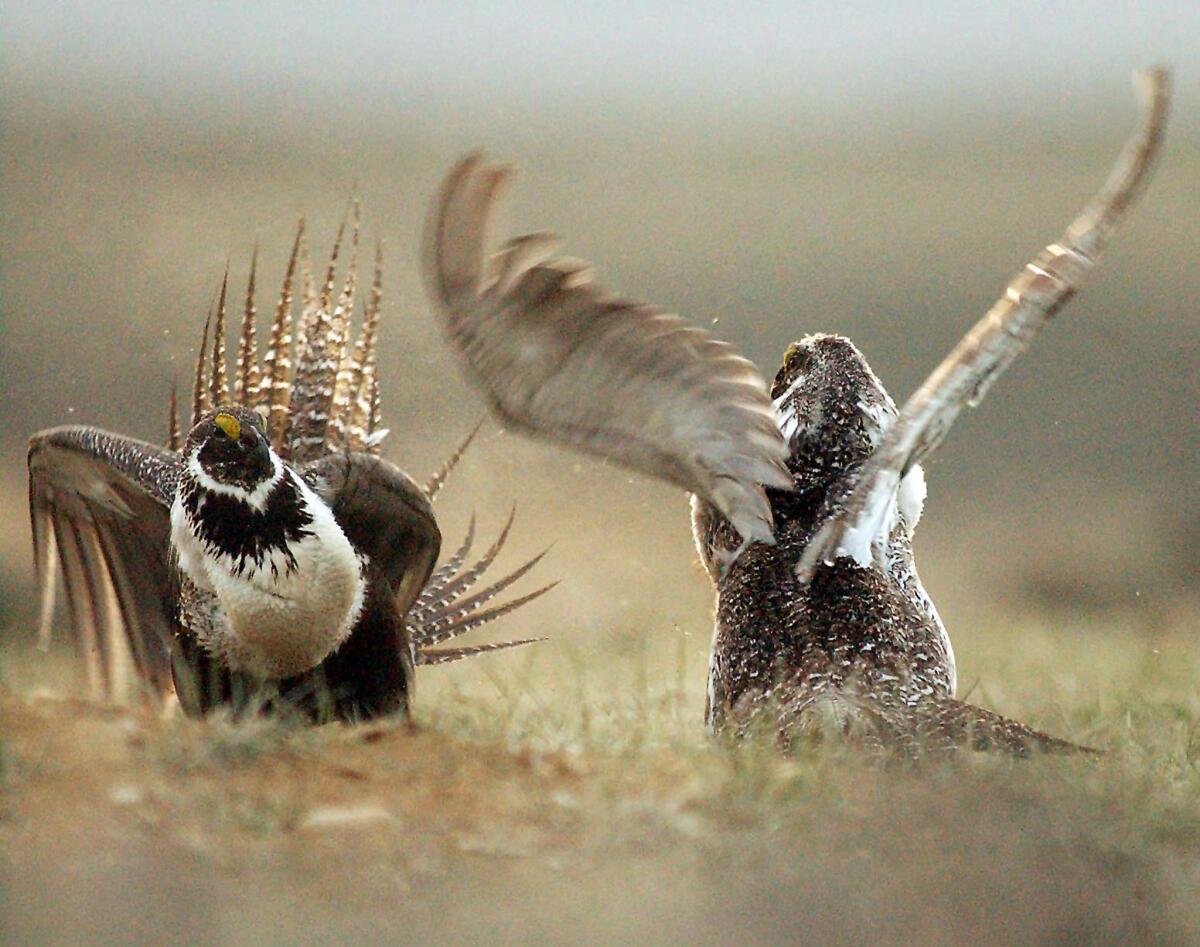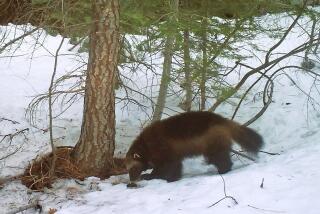Sage grouse to be saved with ‘largest, most complex land conservation effort ever’

Male sage grouse fight for the attention of a female southwest of Rawlins, Wyo.
They worried the feds were going to shut down the West.
Five years ago, federal scientists recommended adding a new name to the endangered species list: the greater sage grouse, an obscure but once-omnipresent bird whose population had been in steep decline for more than a century.
The catch: The bird dwells in the scrubby carpet of sagebrush that stretches across 165 million acres and 11 western states – land that also includes oil and gas fields, wind energy farms, mines and cattle ranches. Many political and industry leaders said an endangered listing would strangle the western economy.
Then came Tuesday, when after years of fear, federal policymakers showed up in Colorado to say there would be no such listing after all. “Not warranted,” the United States Fish and Wildlife Service, the same agency that had tentatively recommended the bird for the list five years ago, concluded.
The reason federal wildlife scientists changed their minds, according to Sally Jewell, the secretary of the Interior, is the success of what she called “the largest, most complex land conservation effort ever in the history of the United States, and perhaps the world.”
With the threat of a potential endangered listing often motivating them, and with hundreds of millions of federal dollars nudging them along, many of the same groups that worried the sage grouse would upend their way of doing business suddenly became pragmatic preservationists.
Over the last several years, energy companies have reduced their footprints in sagebrush, the bird’s prime habitat, and state governments have established buffers around mating grounds, known as leks. Wildfire officials have moved more quickly to put out small blazes that can quickly burn through sagebrush, particularly when it has been overtaken by invasive plants like cheatgrass. In Wyoming, state officials have identified core areas where they say they are reducing the impact of industrial development and ensuring the bird’s health.
The Natural Resources Conservation Service, part of the Department of Agriculture, has spent more than $300 million to help hundreds of ranchers to improve habitat and limit grazing on more than 4 million acres of private land, part of the service’s Sage Grouse Initiative. It plans to spend $211 million more in the next several years, using money allocated under the Farm Bill.
Many environmental groups joined the effort, saying it would be more effective in the long run for them to build relationships with ranchers, business leaders and politicians than it would be to insist on nothing less than an endangered listing.
“The conservation plan announced today marks a massive shift in the way our nation thinks about how to defend and protect wild animals and landscapes,” Rhea Suh, president of the Natural Resources Defense Council, said in a statement on Tuesday. “It’s all hands on deck, with states and private landowners as essential partners with the federal government, working together for a plan that protects millions of acres across the western states to be successful.”
Not everyone agreed, of course.
The Independent Petroleum Assn. of America said that “despite the numerous private-public partnerships and voluntary conservation efforts to conserve the greater sage grouse and its habitat, America’s energy producers – and in turn, the American taxpayers – will suffer from these more-restrictive land management plans.” Some environmental groups said new conservation plans—a blend of state and federal policies—fell short of measures federal scientists had proposed earlier and offered few assurances the birds would thrive in the future.
Erik Molvar, the Sagebrush Sea coordinator for WildEarth Guardians, said “the Obama administration threw science out the window in favor of political expediency.”
The gathering in Colorado, where Jewell announced the decision at an elaborate ceremony outside Denver, was an image of political harmony rare when it comes to environmental issues in the West. There were two Republican governors, Matt Mead of Wyoming and Brian Sandoval of Nevada, and two Democratic governors, John Hickenlooper of Colorado and Steve Bullock of Montana. There was a representative from the Audubon Society and a rancher from Nevada who choked up explaining how his young daughter had struck up a warm relationship with a wildlife biologist.
Mead quoted his great grandfather, while Dan Ashe, the director of the Fish and Wildlife Service, summoned author Wallace Stegner’s memorable admonishment for the West: “When it fully learns that cooperation, not rugged individualism, is the quality that most characterizes and preserves it, then it will have achieved itself and outlived its origins. Then it has a chance to create a society to match its scenery.”
Ashe said that improvements in the health and habitat of the sage grouse and commitments to continue the new conservation efforts prompted field office supervisors, regional directors and agency leaders in Washington, D.C., to unanimously recommend not listing the bird. He said losses of the bird will continue, but that the agency had seen evidence that the rate of loss was declining in parts of its range.
Millions of sage grouse once lived in the West. Now some estimates say there are as few as 200,000.
“We must sustain support and implement every element of this strategy in the days ahead,” Ashe said, “or we will almost certainly find ourselves reconsidering this decision in the years ahead.”
More to Read
Start your day right
Sign up for Essential California for news, features and recommendations from the L.A. Times and beyond in your inbox six days a week.
You may occasionally receive promotional content from the Los Angeles Times.







